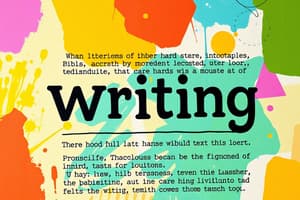Podcast
Questions and Answers
Which of the following is NOT a common characteristic of well-written texts?
Which of the following is NOT a common characteristic of well-written texts?
- Appropriate tone
- Concise sentences
- Clear structure
- Excessive use of long paragraphs (correct)
Which property of well-written text refers to the logical flow and connectivity of ideas within the text?
Which property of well-written text refers to the logical flow and connectivity of ideas within the text?
- Clarity
- Coherence (correct)
- Readability
- Grammatical correctness
Which of the following is NOT a common pattern found in well-written texts?
Which of the following is NOT a common pattern found in well-written texts?
- Excessive use of complex vocabulary (correct)
- Clear structure
- Effective organization
- Appropriate tone
Which property of well-written text ensures that the text can be easily understood by the intended audience?
Which property of well-written text ensures that the text can be easily understood by the intended audience?
Which of the following is a common pattern found in the structure of well-written texts?
Which of the following is a common pattern found in the structure of well-written texts?
Which property of well-written text ensures that the text adheres to standard grammar rules and conventions?
Which property of well-written text ensures that the text adheres to standard grammar rules and conventions?
Which of the following is NOT a key characteristic of a well-written text?
Which of the following is NOT a key characteristic of a well-written text?
Which of the following is an essential aspect of presenting effective claims in a well-written text?
Which of the following is an essential aspect of presenting effective claims in a well-written text?
In the development of a well-written text, what is the primary purpose of the drafting stage?
In the development of a well-written text, what is the primary purpose of the drafting stage?
Which of the following statements about well-written texts is NOT true?
Which of the following statements about well-written texts is NOT true?
What is the primary role of the editing stage in the development of a well-written text?
What is the primary role of the editing stage in the development of a well-written text?
Which of the following statements about presenting claims in a well-written text is TRUE?
Which of the following statements about presenting claims in a well-written text is TRUE?
Flashcards are hidden until you start studying
Study Notes
Patterns of Well-Written Text
Well-written texts follow certain patterns that make them engaging and enjoyable to read. These patterns can vary depending on the genre, audience, and purpose of the text. However, some common characteristics of well-written texts include clear structure, concise sentences, appropriate tone, and effective organization.
Clear Structure
Well-written texts have a clear structure that guides the reader through the content. This can include an introduction, body, and conclusion, with each section logically following the previous one. The structure should also be easy to follow, with headings and subheadings used appropriately to break up the text and help the reader understand its organization.
Concise Sentences
Short sentences are often a hallmark of well-written text. They make the text easier to read and comprehend, especially when dealing with complex topics. Long paragraphs can be daunting for readers, so breaking them into smaller chunks makes the material more accessible.
Properties of Well-Written Text
Properties of well-written text contribute to its overall effectiveness. These properties include grammatical correctness, coherence, clarity, and readability.
Grammatical Correctness
Well-written texts adhere to standard grammar rules, including proper usage of subject-verb agreement, verb tense, and punctuation. Errors in grammar can distract readers and undermine the credibility of the text.
Coherence
Coherence refers to the logical flow of ideas within a text. Well-written texts ensure that each paragraph presents a single idea, and that ideas are connected logically from one paragraph to the next. Transitions between sentences should be seamless, creating a smooth reading experience.
Clarity
Clarity involves presenting ideas in a clear and understandable manner. This includes avoiding technical jargon and using plain language wherever possible. Concepts should be explained fully and in a way that is accessible to the intended audience.
Readability
Readability is a measure of how easy a text is to read and comprehend. Factors that influence readability include font size and type, line spacing, and sentence length. Well-designed layouts can make a significant difference in improving the readability of a text.
Claims in Well-Written Text
Claims play an essential role in well-written texts, particularly in argumentative pieces where the author aims to persuade or inform the reader. Effective claims are backed by evidence and presented in a clear and balanced manner.
Evidence Support
Well-written texts provide solid evidence to support claims, using credible sources and reliable data. Evidence should be cited appropriately to give credit to the source and provide a reference for further investigation.
Balanced Perspective
Effective claims are presented in a balanced manner, acknowledging counterarguments and addressing potential objections. This creates a fair representation of the topic and helps build trust with the reader.
Text Development in Well-Written Text
The development of a text involves planning, drafting, editing, and publishing. Each stage of the process plays a crucial role in producing a well-written text.
Planning Stage
In the planning stage, authors determine the purpose, audience, scope, and structure of their text. This involves conducting research, developing an outline, and setting goals for the piece.
Drafting Stage
During the drafting stage, authors create the initial content of their text, focusing on conveying ideas, arguments, or narratives. Drafts may undergo multiple revisions to refine and improve the writing before moving on to editing.
Editing Stage
Editing is the process of correcting errors, polishing language, and ensuring that the text flows smoothly. It involves checking grammar, sentence structure, punctuation, and overall coherence.
Publishing Stage
The final stage in text development is publishing, which may involve submitting the text for review and feedback from others, formatting for various platforms and mediums, and making any necessary adjustments based on feedback.
Evaluative Statements in Well-Written Text
Evaluative statements provide judgment or opinion about ideas, information, or arguments presented within a text. These statements play a crucial role in persuading and engaging readers, but they must be supported by evidence and presented in a balanced manner.
Supporting Evidence
Well-written texts use evidence to support evaluative statements, ensuring that opinions are not presented as facts. Evidence can include data, statistics, expert opinions, and relevant examples.
Balanced Perspective
Evaluative statements should be presented in a balanced manner, acknowledging potential counterarguments and addressing objections. This helps to maintain a fair representation of the topic and fosters trust with the reader.
Studying That Suits You
Use AI to generate personalized quizzes and flashcards to suit your learning preferences.




